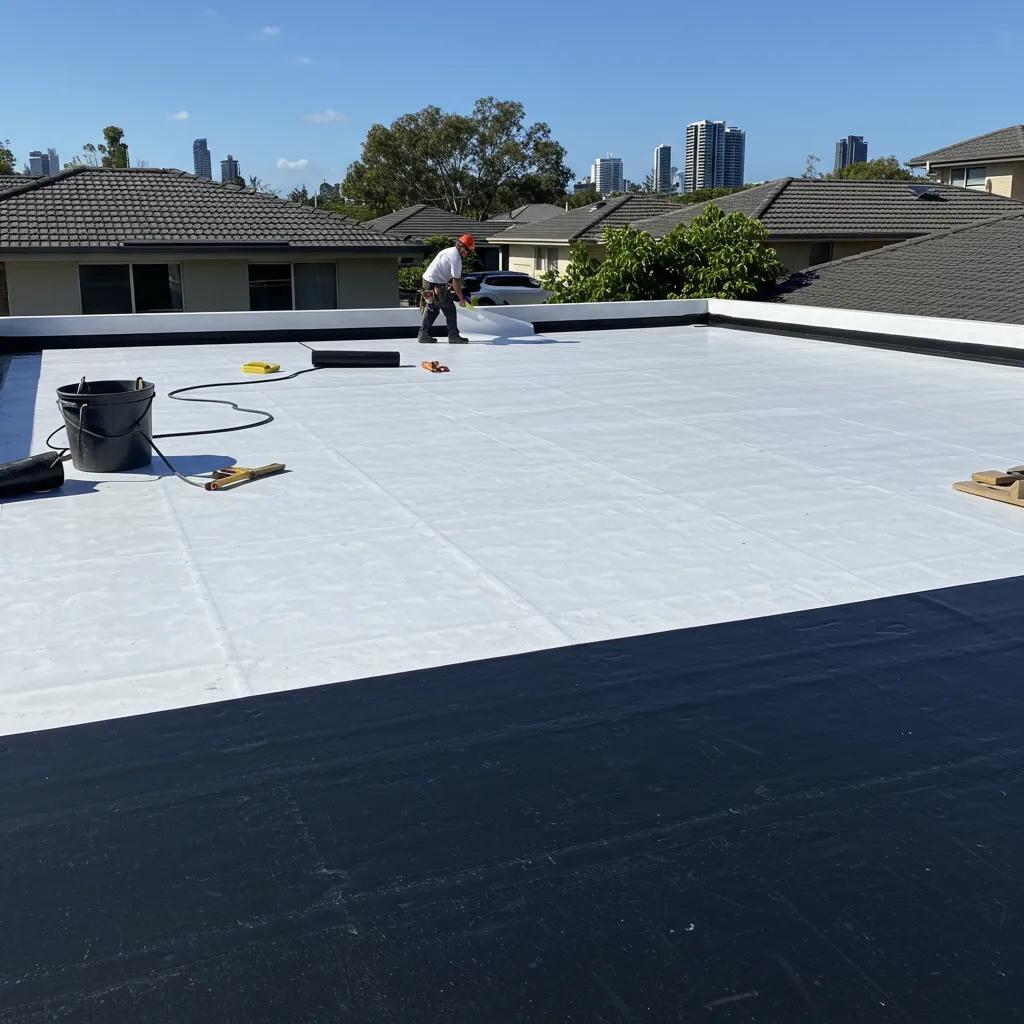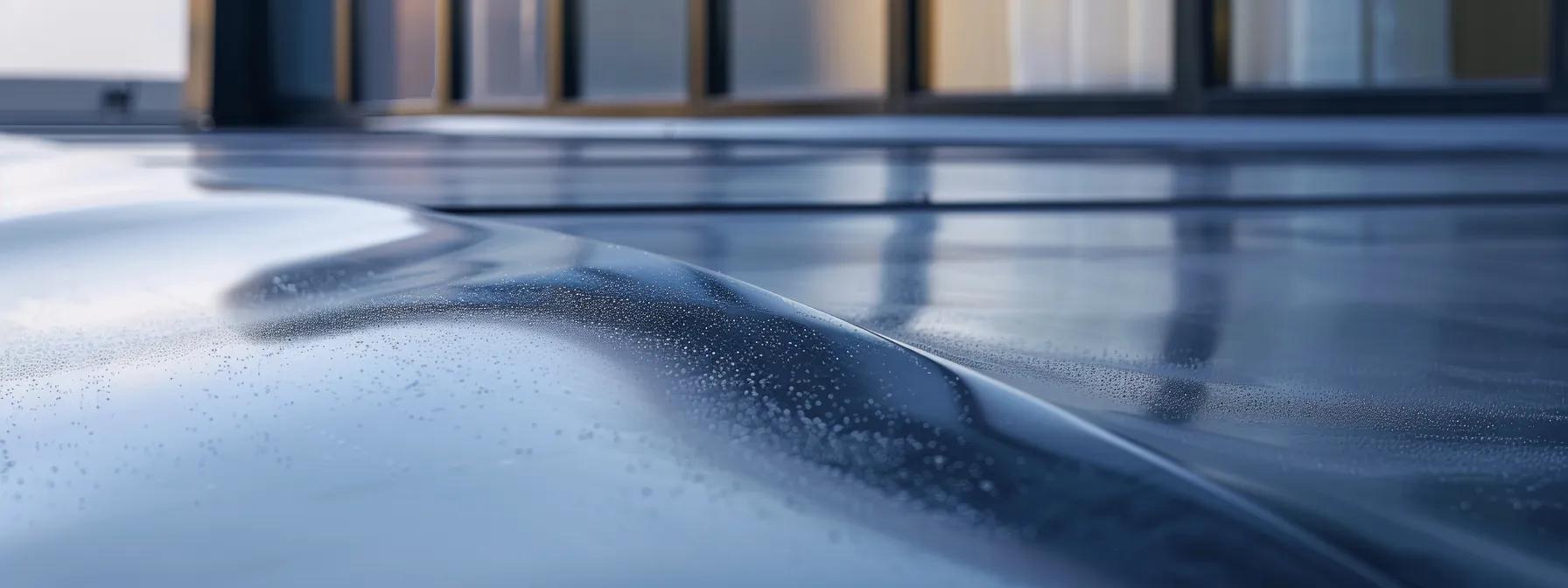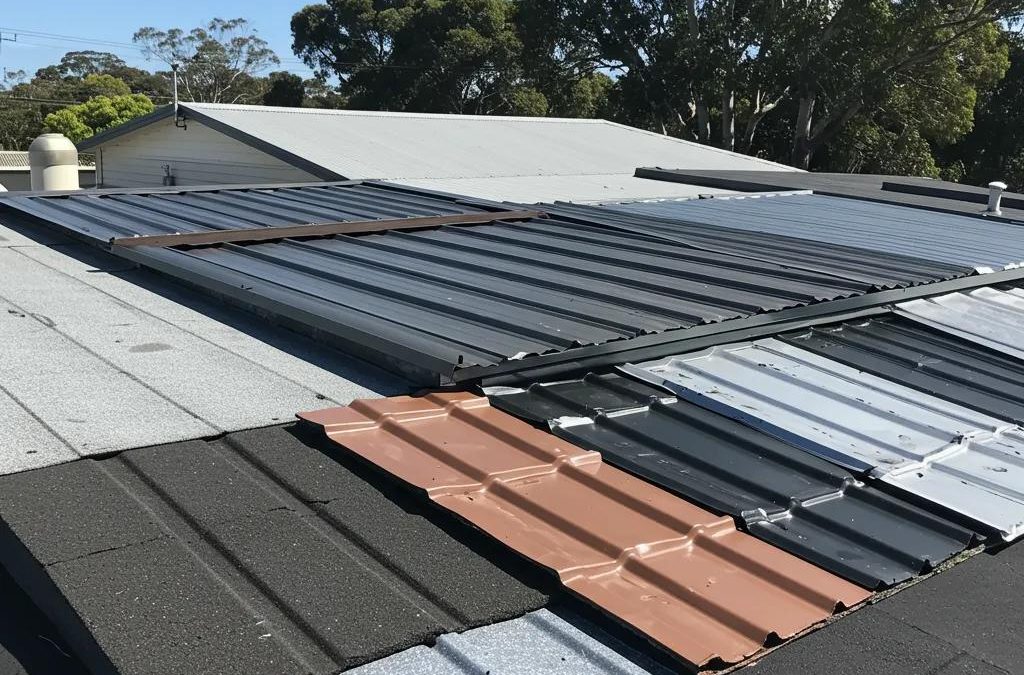Flat Roof Material Options You Need to Know: Expert Guide for Brisbane Homeowners
Choosing the ideal flat roof material can protect your home from Brisbane’s intense sun and seasonal downpours while reducing long-term maintenance and energy costs. This guide will help you navigate core material characteristics, climate-driven selection factors, budget and performance considerations, insulation and waterproofing solutions, maintenance best practices, cost comparisons and an unbiased pros-and-cons overview. You will discover how EPDM, TPO, PVC, modified bitumen, built-up roofing (BUR), fibreglass (GRP) and metal systems perform under Queensland conditions, plus expert insights on drainage, insulation, installation and lifespan management. With local expertise from Roofing Specialist and practical decision-making frameworks, you can select the right flat roof material option to maximise durability and efficiency for your Brisbane home.
What Are the Best Flat Roof Materials for Brisbane Homes?
Flat roof material options vary in durability, cost and energy performance. In Brisbane’s subtropical climate, single-ply membranes and robust layering systems deliver reliable waterproofing, UV resistance and thermal benefits. Below is a comparative overview of key roofing products.
This comparison underscores how durability and installation technique influence long-term performance, guiding the next step: examining each product’s unique advantages.
Why Choose EPDM Rubber Roofing for Your Flat Roof?
EPDM rubber roofing is a synthetic membrane renowned for high tensile strength and weather resistance. It forms a continuous barrier that resists ozone, UV degradation and temperature extremes, making it ideal for Brisbane’s heat and occasional storms. Homeowners benefit from a membrane that expands and contracts with temperature shifts without cracking, reducing repair frequency. Roofing Specialist recommends white EPDM variants to minimise heat absorption and improve cooling efficiency, ensuring energy savings and long-term protection.
How Does TPO Roofing Improve Energy Efficiency in Hot Climates?

TPO roofing uses a reflective white thermoplastic surface to bounce back up to 85 percent of solar radiation. This mechanism reduces heat transfer into the building envelope, lowering air-conditioning loads and cutting energy bills. Its welded seams create a continuous surface free of mechanical penetrations that can leak, enhancing waterproofing. Many Brisbane homeowners choose TPO for its balance of cost-effectiveness, UV stability and ease of installation by professional roofers.
What Makes PVC Flat Roofing Durable and Cost-Effective?
PVC flat roofing combines high tensile strength with superior chemical and fire resistance. The polymeric membrane resists oil, grease and cleaning solvents, making it suitable for roofs with rooftop plant equipment. Its welded seams deliver watertight integrity while the reflective surface reduces heat gain. PVC’s proven lifespan of up to 30 years, coupled with moderate installation costs, positions it as a cost-effective solution for long-term value in Queensland conditions.
When Is Modified Bitumen Roofing the Right Choice?
Modified bitumen roofing consists of asphalt reinforced with polymers and carrier sheets for enhanced flexibility. Torch-on systems adhere directly to the substrate, while self-adhesive versions speed installation without open flames. This material suits projects where low upfront cost and ease of repair matter most, though its typical lifespan of 15–20 years is shorter than single-ply membranes. Homeowners seeking traditional roofing solutions with straightforward patch repairs often select modified bitumen for budget-conscious installations.
EPDM, PVC, TPO: Common Materials for Flat Roof Membranes
…, among which the most common are EPDM, PVC, TPO, and ketone ethylene esters (KEE). … conducted a three-year study comparing roofing membranes and found that the cooling loads …| Rubber and Rubber-Like Products for Low-Slope Roofing Applications, RM Paroli, 2023
What Are the Advantages of Built-Up Roofing (BUR) Systems?
Built-up roofing layers alternating bitumen and reinforcing fabrics, topped with a surfacing aggregate for UV protection. This multi-ply composition delivers robust waterproofing, sound insulation and fire resistance. Its layered design resists foot traffic and mechanical damage, supporting roof-accessible areas. With proper drainage and periodic maintenance, a BUR system can exceed 25 years in service, making it a trusted option for commercial-style flat roofs on residential properties.
How Does Fibreglass (GRP) Roofing Provide a Seamless Finish?

Fibreglass roofing uses a resin-impregnated reinforcement mat to create a monolithic, joint-free surface that excels at stopping leaks. Its seamless nature prevents water ingress at laps or seams and repairs can be carried out locally without redoing the full roof. GRP’s high strength-to-weight ratio withstands impact from hail and debris, while its UV-stable resin resists colour fading. Brisbane homeowners value its low maintenance and adaptability for complex roof geometries.
What Are the Benefits and Costs of Metal Flat Roofing?
Standing-seam metal roofing uses interlocking metal panels to form a watertight seam system. Its reflective finish reduces solar heat load and panels deliver exceptional wind uplift resistance. While material and installation costs are higher—ranging between AUD 50–65 per square metre—metal roofs can last beyond 40 years with minimal upkeep. For homeowners focused on longevity, curb appeal and recyclability, standing-seam metal represents a premium but enduring choice.
How Do Climate and Local Conditions Affect Flat Roof Material Selection?
Selecting a flat roof material for Brisbane requires careful alignment with regional weather patterns, drainage demands and building standards. Local temperature swings, UV exposure and heavy rainfall periods dictate the membrane’s resilience, insulation needs and installation tolerances.
What Brisbane Weather Challenges Influence Flat Roof Durability?
Brisbane experiences hot summers with UV indices often above 11 and seasonal thunderstorms delivering intense rainfall. High-energy UV degrades unsuitable membranes, while sudden downpours demand rapid runoff to prevent ponding. Materials that offer UV stabilisers, reflective surfaces and flexible elongation resist cracking and breakdown under these cyclic stresses. A robust drainage design paired with UV-resistant membranes ensures consistent performance year-round.
How Does Material Choice Affect Flat Roof Lifespan in Brisbane?
Membranes with inherent UV resistance and dimensional stability—such as EPDM, TPO and metal—extend service life to 30–50 years. Products prone to hardening or brittleness under heat, like traditional bitumen without modifiers, may degrade within 15 years. Selecting a material rated for local solar and thermal conditions, combined with professional installation to tighten seams and flashings, safeguards against premature failure and costly re-roofs.
Why Is Proper Drainage Critical for Flat Roof Performance?
Even a minimal slope of 1–2 degrees directs rainwater toward roof outlets and downpipes, preventing ponding that accelerates membrane wear. Tapered insulation or cranked fall systems guides water efficiently. Without adequate falls, debris accumulates in low spots, trapping moisture and encouraging algae growth. Ensuring clear roof drains and well-engineered falls reduces stress on seams and prolongs membrane integrity.
How Do Local Building Regulations Impact Material Options?
Brisbane building codes mandate specific fire ratings, wind uplift resistances and insulation values for low-slope roofs. Certain council areas require compliance with energy-efficiency targets that influence membrane reflectivity and insulation R-values. Engaging a licensed roofing specialist familiar with Queensland’s regulatory framework ensures material selection and installation practices adhere to statutory requirements, avoiding compliance delays or retrofit costs.
What Are the Key Factors to Consider When Choosing Flat Roof Materials?
Defining selection criteria helps homeowners balance performance, cost and long-term value. Key considerations include upfront budget, maintenance frequency, energy efficiency, lifespan expectations and potential roof-top usage.
How Do Budget and Installation Costs Vary by Material?
Material and labour rates differ widely: single-ply membranes like TPO and PVC cost between AUD 50–80 per square metre including installation, whereas modified bitumen installs at around AUD 40–60 per square metre. Premium metal roofing can exceed AUD 100 per square metre. Labour complexity and roof geometry influence overall project costs, so accurate quotes from experienced installers help set realistic budgets.
What Maintenance Requirements Should Homeowners Expect?
Some materials require periodic cleaning and seam inspections; for example, EPDM benefits from annual debris removal and seam sealant checks. BUR systems may demand re-application of surfacing aggregate or bitumen coatings every 10 years. Metal roofs need flashings and sealant joints verified after high winds. Understanding each system’s upkeep profile guides homeowners toward manageable long-term commitments.
How Important Is Energy Efficiency and Insulation for Flat Roofs?
Reflective membranes such as white TPO or PVC significantly cut thermal gains, reducing cooling loads by up to 30 percent. High-R-value insulation boards like polyisocyanurate enhance thermal performance and are often tapered to support drainage. A combined system of reflective membrane and quality insulation optimises indoor comfort and minimises energy expenditure, aligning with sustainability goals.
Can Flat Roofs Support Additional Uses Like Solar Panels or Gardens?
Flat roofs provide an ideal platform for photovoltaic systems and lightweight green-roof modules. Materials such as metal and single-ply membranes withstand panel racking and garden tray installations when correctly reinforced. Engagement with a roofing specialist ensures structural capacities, waterproofing integrity and warranty conditions remain intact when integrating rooftop amenities.
What Are the Best Insulation Options for Flat Roofs?
Effective insulation underpins thermal comfort and energy savings. Brisbane homes benefit from high-performance boards that resist moisture and support drainage functionality.
How Does Polyisocyanurate (Polyiso) Insulation Enhance Thermal Performance?
Polyiso delivers among the highest R-values per unit thickness, often exceeding R 3.5 per 25 mm. Its closed-cell structure limits moisture absorption and maintains insulation integrity over decades. Polyiso’s rigid boards can be tapered to create built-in falls, ensuring consistent drainage. This combination of performance and adaptability makes polyiso a preferred choice for flat roofs in warm climates.
What Are the Differences Between XPS and EPS Insulation Types?
Extruded polystyrene (XPS) offers superior compressive strength and moisture resistance compared with expanded polystyrene (EPS), making it ideal for roof decks with foot traffic. EPS remains more cost-effective but absorbs slightly more moisture over time. Both types deliver R 2.5–3.0 per 25 mm, and selection depends on load-bearing requirements and budget priorities, with XPS preferred under heavier installations.
Why Is Tapered Insulation Important for Flat Roof Drainage?
Tapered insulation creates engineered falls that direct water to drains and scuppers, preventing ponding and membrane stress. Without adequate slope, water collects in low-lying areas, accelerating material deterioration. A tapered stack design integrates with waterproofing and structural substrate, ensuring consistent runoff and extending roof lifespan under Brisbane’s rainfall patterns.
How Can You Waterproof Your Flat Roof Effectively?
Waterproofing is the primary defence against leaks and structural damage. A combination of suitable membranes, coatings and detailing ensures a reliable barrier.
What Are the Advantages of Liquid Membrane Waterproofing?
Liquid-applied membranes cure into seamless elastomeric coatings that bridge minor cracks and follow complex roof contours. They accommodate substrate movement without splitting and can be applied over many existing surfaces. Their ease of application makes liquid membranes a cost-effective option for repair work and irregular roof profiles, providing instant water-tight protection once cured.
How Do EPDM, TPO, and PVC Membranes Compare for Waterproofing?
All three single-ply membranes deliver continuous waterproof barriers, but their chemical composition influences performance:
- EPDM offers superior flexibility and resistance to thermal shock.
- TPO provides exceptional UV reflectivity and seam integrity.
- PVC resists grease and chemical spills common around rooftop equipment.
Choosing among them depends on roof exposure, maintenance access and long-term performance goals, with professional installation crucial for watertight seams.
What Techniques Ensure Long-Lasting Flat Roof Waterproofing?
Critical practices include ensuring proper substrate preparation, installing membranes with fully welded or adhered seams, and sealing all penetrations with compatible flashings. Regular roof inspections catch early signs of seam separation or membrane punctures. Roofing Specialist recommends scheduled preventative maintenance plans to preserve membrane integrity in Brisbane’s climate.
How Should You Maintain Your Flat Roof to Maximise Lifespan?
Proactive maintenance extends performance and identifies minor issues before they escalate. Consistent inspection routines and prompt interventions safeguard waterproofing and structural integrity.
What Are the Essential Flat Roof Inspection Steps?
Homeowners should inspect membranes after significant weather events and at least twice a year. Check for debris accumulation, seam splits, blistering, ponding water and blocked drains. Examine flashings around vents and skylights for sealant cracks. Early detection of small defects allows simple patch repairs before major leaks develop.
How Do You Prevent and Address Ponding Water Issues?
Regularly clear leaves and sediment from outlets and scuppers to maintain flow. Where water accumulation persists, introduce additional drainage paths or adjust falls via tapered boards or cranked profiles. Applying anti-ponding fabric or installing siphonic drainage systems can further accelerate runoff and eliminate residual standing water.
When Is Professional Maintenance Recommended Over DIY?
DIY efforts suit debris removal, basic drain cleaning and minor patching with compatible sealants. However, complex repairs—such as membrane reseaming, structural fall adjustments or extensive re-coating—require trained installers with specialised equipment. Engaging a licensed roofing specialist ensures compliance with warranty and local building standards.
What Are the Typical Costs of Flat Roof Materials and Installation in Brisbane?
Budgeting accurately involves material pricing, labour rates and ancillary expenses like disposal and scaffolding. Regional demand and roof complexity also influence quotes.
How Do Material Prices Compare for Common Flat Roof Options?
Material-only cost ranges per square metre (AUD):
- EPDM Rubber: 25–40
- TPO Single-Ply: 20–35
- PVC Single-Ply: 25–40
- Modified Bitumen: 15–25
- BUR System: 30–50
- GRP Fibreglass: 35–55
- Standing-Seam Metal: 60–100
These figures exclude labour and supply charges, which typically add 30–50 percent to the total.
What Installation Factors Influence Overall Project Costs?
Roof access complexity, substrate repairs, drainage upgrades and insulation requirements all affect labour hours. Steeper falls or intricate details around skylights and parapets prolong installation time. Local permit fees and disposal of old membranes also contribute. Obtaining multiple detailed quotes helps isolate cost drivers and clarify service inclusions.
Are There Long-Term Savings from Choosing More Durable Materials?
Investing in higher-quality membranes such as EPDM or standing-seam metal can yield lifecycle cost reductions by minimising repair interventions and deferring full replacements. Energy-efficient membranes lower ongoing cooling expenses. Factoring in maintenance schedules and warranty coverage, premium materials often demonstrate superior return on investment over a 30-year horizon.
What Are the Pros and Cons of Different Flat Roof Materials?
Balanced insights into strengths and limitations of each option support informed decisions that align with homeowner priorities and site conditions.
What Are the Main Advantages of EPDM, TPO, and PVC Roofing?
- EPDM offers unmatched flexibility, long lifespan and simple repairs.
- TPO excels in UV reflectivity, energy savings and seam strength.
- PVC provides chemical resistance, fire retardance and a reflective surface.
These membranes combine ease of installation with reliable waterproofing when professionally applied.
What Disadvantages Should You Consider for Modified Bitumen and BUR?
- Modified bitumen systems have shorter lifespans and may become brittle under prolonged heat exposure.
- BUR installations are labour-intensive, heavier on the structure and require regular surfacing maintenance. Both options demand more frequent upkeep than single-ply membranes.
How Do Fibreglass and Metal Roofing Compare in Longevity and Cost?
- Fibreglass delivers seamless waterproofing and moderate installation costs but may require re-coating over decades.
- Metal roofing offers exceptional longevity and recyclability but carries higher upfront expenses. Both options resist punctures and hail better than many membranes, enhancing durability in severe weather.
How Do Flat Roof Drainage Challenges Affect Material Choice?
Materials that tolerate minor ponding—such as EPDM and liquid membranes—offer safety margins for imperfect falls, whereas rigid systems like BUR demand precise drainage engineering. Understanding how each membrane interacts with water retention guides selection toward products with compatible drainage tolerances and installation practices.
Effective roofing solutions arise from matching material properties to site conditions, budget limits and performance expectations. By evaluating durability, energy performance, maintenance needs and costs, Brisbane homeowners can partner with a qualified roofing specialist to implement the optimal flat roof material option for lasting protection and comfort.

